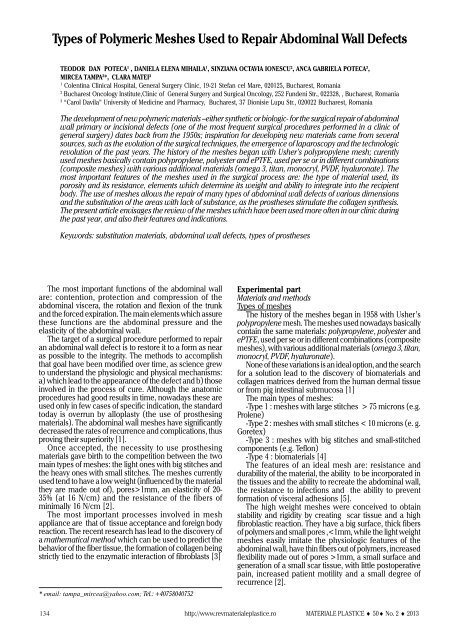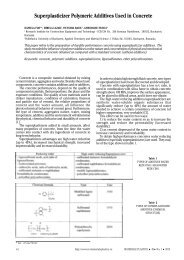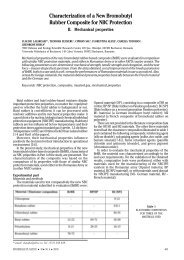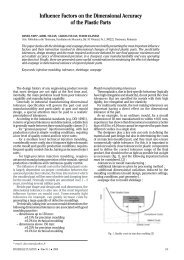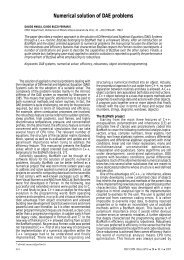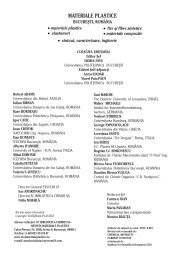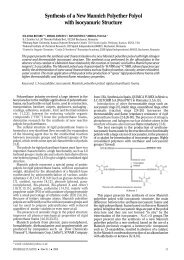POTECA T - revista de materiale plastice
POTECA T - revista de materiale plastice
POTECA T - revista de materiale plastice
You also want an ePaper? Increase the reach of your titles
YUMPU automatically turns print PDFs into web optimized ePapers that Google loves.
Types of Polymeric Meshes Used to Repair Abdominal Wall Defects<br />
TEODOR DAN <strong>POTECA</strong> 1 , DANIELA ELENA MIHAILA 1 , SINZIANA OCTAVIA IONESCU 2 , ANCA GABRIELA <strong>POTECA</strong> 3 ,<br />
MIRCEA TAMPA 3 *, CLARA MATEI 3<br />
1<br />
Colentina Clinical Hospital, General Surgery Clinic, 19-21 Stefan cel Mare, 020125, Bucharest, Romania<br />
2<br />
Bucharest Oncology Institute,Clinic of General Surgery and Surgical Oncology, 252 Fun<strong>de</strong>ni Str., 022328, , Bucharest, Romania<br />
3<br />
“Carol Davila” University of Medicine and Pharmacy, Bucharest, 37 Dionisie Lupu Str., 020022 Bucharest, Romania<br />
The <strong>de</strong>velopment of new polymeric materials –either synthetic or biologic- for the surgical repair of abdominal<br />
wall primary or incisional <strong>de</strong>fects (one of the most frequent surgical procedures performed in a clinic of<br />
general surgery) dates back from the 1950s; inspiration for <strong>de</strong>veloping new materials came from several<br />
sources, such as the evolution of the surgical techniques, the emergence of laparoscopy and the technologic<br />
revolution of the past years. The history of the meshes began with Usher’s polypropylene mesh; curently<br />
used meshes basically contain polypropylene, polyester and ePTFE, used per se or in different combinations<br />
(composite meshes) with various additional materials (omega 3, titan, monocryl, PVDF, hyaluronate). The<br />
most important features of the meshes used in the surgical process are: the type of material used, its<br />
porosity and its resistance, elements which <strong>de</strong>termine its weight and ability to integrate into the recipient<br />
body. The use of meshes allows the repair of many types of abdominal wall <strong>de</strong>fects of various dimensions<br />
and the substitution of the areas with lack of substance, as the prostheses stimulate the collagen synthesis.<br />
The present article envisages the review of the meshes which have been used more often in our clinic during<br />
the past year, and also their features and indications.<br />
Keywords: substitution materials, abdominal wall <strong>de</strong>fects, types of prostheses<br />
The most important functions of the abdominal wall<br />
are: contention, protection and compression of the<br />
abdominal viscera, the rotation and flexion of the trunk<br />
and the forced expiration. The main elements which assure<br />
these functions are the abdominal pressure and the<br />
elasticity of the abdominal wall.<br />
The target of a surgical procedure performed to repair<br />
an abdominal wall <strong>de</strong>fect is to restore it to a form as near<br />
as possible to the integrity. The methods to accomplish<br />
that goal have been modified over time, as science grew<br />
to un<strong>de</strong>rstand the physiologic and physical mechanisms:<br />
a) which lead to the appearance of the <strong>de</strong>fect and b) those<br />
involved in the process of cure. Although the anatomic<br />
procedures had good results in time, nowadays these are<br />
used only in few cases of specific indication, the standard<br />
today is overrun by alloplasty (the use of prosthesing<br />
materials). The abdominal wall meshes have significantly<br />
<strong>de</strong>creased the rates of recurrence and complications, thus<br />
proving their superiority [1].<br />
Once accepted, the necessity to use prosthesing<br />
materials gave birth to the competition between the two<br />
main types of meshes: the light ones with big stitches and<br />
the heavy ones with small stitches. The meshes currently<br />
used tend to have a low weight (influenced by the material<br />
they are ma<strong>de</strong> out of), pores>1mm, an elasticity of 20-<br />
35% (at 16 N/cm) and the resistance of the fibers of<br />
minimally 16 N/cm [2].<br />
The most important processes involved in mesh<br />
appliance are that of tissue acceptance and foreign body<br />
reaction. The recent research has lead to the discovery of<br />
a mathematical method which can be used to predict the<br />
behavior of the fiber tissue, the formation of collagen being<br />
strictly tied to the enzymatic interaction of fibroblasts [3]<br />
* email: tampa_mircea@yahoo.com; Tel.: +40758040752<br />
Experimental part<br />
Materials and methods<br />
Types of meshes<br />
The history of the meshes began in 1958 with Usher’s<br />
polypropylene mesh. The meshes used nowadays basically<br />
contain the same materials: polypropylene, polyester and<br />
ePTFE, used per se or in different combinations (composite<br />
meshes), with various additional materials (omega 3, titan,<br />
monocryl, PVDF, hyaluronate).<br />
None of these variations is an i<strong>de</strong>al option, and the search<br />
for a solution lead to the discovery of biomaterials and<br />
collagen matrices <strong>de</strong>rived from the human <strong>de</strong>rmal tissue<br />
or from pig intestinal submucosa [1]<br />
The main types of meshes:<br />
-Type 1 : meshes with large stitches > 75 microns (e.g.<br />
Prolene)<br />
-Type 2 : meshes with small stitches < 10 microns (e. g.<br />
Goretex)<br />
-Type 3 : meshes with big stitches and small-stitched<br />
components (e.g. Teflon)<br />
-Type 4 : biomaterials [4]<br />
The features of an i<strong>de</strong>al mesh are: resistance and<br />
durability of the material, the ability to be incorporated in<br />
the tissues and the ability to recreate the abdominal wall,<br />
the resistance to infections and the ability to prevent<br />
formation of visceral adhesions [5].<br />
The high weight meshes were conceived to obtain<br />
stability and rigidity by creating scar tissue and a high<br />
fibroblastic reaction. They have a big surface, thick fibers<br />
of polymers and small pores ,1mm, a small surface and<br />
generation of a small scar tissue, with little postoperative<br />
pain, increased patient motility and a small <strong>de</strong>gree of<br />
recurrence [2].<br />
134<br />
http://www.rev<strong>materiale</strong><strong>plastice</strong>.ro<br />
MATERIALE PLASTICE ♦ 50♦ No. 2 ♦ 2013
Although they have biocompatibility, the materials used<br />
are not biologically inert, as they have physical and<br />
chemical properties which lead to the well-known<br />
complications of alloplasty: infections, adhesions,<br />
seromas, fistulae, fibrosis, calcification, inflammation and<br />
thrombosis. The integration of the mesh into the tissue is<br />
done with the help of an intense inflammatory process,<br />
which involves the use of chemotaxis and the invasion of<br />
the area with macrophages and monocytes.<br />
On the other hand, those meshes which are biologically<br />
inert sometimes have a strong and violent reaction of<br />
foreign body rejection, as they form granulomas,<br />
multinuclear cells resulting from the foreign body which<br />
becomes surroun<strong>de</strong>d by macrophages and monocytes .<br />
After fixation, the foreign materials absorb part of the<br />
proteins of the host in a few seconds, process which<br />
prece<strong>de</strong>s even the primary cellular response and has<br />
generated the i<strong>de</strong>a of a phagocyte reaction initiated not by<br />
the presence of the foreign material, but also by the<br />
interaction with products of protein <strong>de</strong>gradation.<br />
Polypropylene, polyethylene terephtalate and expan<strong>de</strong>d<br />
poly-tetra-fluoroethylene are all non absorbable materials<br />
and are components of any mesh [2].<br />
Polypropylene meshes<br />
Polypropylene is a thermoplastic polymer obtained<br />
through the polymerization of propylene.<br />
Formula :<br />
(C 3<br />
H 6<br />
) n<br />
Normally, this material is flexible and tough, mostly co<br />
polymerized with ethylene, resistant to high temperatures<br />
and low weight; with big resistance to the action of organic<br />
solutes, aliphatic and based on chlorine. Polypropylene is<br />
colorless and easy to dye. The material is obtained by<br />
Ziegler Natta polymerizing reaction.<br />
The melting point for isotactic polypropylene is 171 o C,<br />
whist the melting point of the commercial one is 160-166<br />
o<br />
C, which varies with the crystallization <strong>de</strong>gree. The<br />
syndiotactic polypropylene with a crystallization of 30%<br />
has a melting point of 130 o C[6].<br />
Developed and used for the first time in infected wounds,<br />
the polypropylene meshes were used thereafter on a large<br />
scale and the association between them and previously<br />
mentioned long term complications (adhesions, fistulae,<br />
relapse, infections) was consequently discovered. The<br />
original meshes ma<strong>de</strong> out of polypropylene are those that<br />
form the basis of the monofilament meshes with large<br />
pores, elasticity and big integration ability (Surgipro, Prolene,<br />
Parietene), used in the repairment of the hernias through<br />
laparoscopic procedures[7].<br />
ePTFE meshes<br />
Formula of polymerized tetrafluoroethylene :<br />
The material is obtain through the following reaction:<br />
nF 2<br />
C=CF 2<br />
→ —{ F 2<br />
C—CF 2<br />
}—. ePTFE is a material<br />
<strong>de</strong>veloped by Gore, through the polymerization of teflon,<br />
being a very tough material, with micropores, having the<br />
following properties: resistance, hydrophobia, biocompatibility,<br />
chemical inertness, chemical and thermal<br />
resistance, low friction coefficient, low dielectric constant<br />
and is difficult to inflame. The structure of the meshes<br />
allows gas elimination without allowing the liquids to go<br />
through the membrane[8]. Teflon is a white polymer with<br />
a <strong>de</strong>nsity of ~ 2.2 g/cm 3 , a melting point of 327°C. These<br />
features are due to the carbon-fluori<strong>de</strong> liaisons [9].<br />
These are smooth resistant and light meshes with small<br />
pores which do not allow the formation of adhesions or<br />
intestinal lesions. The low-points of this type of mesh<br />
appear due to the small pores which favour infections, and<br />
most of the time their treatment means the removal of the<br />
mesh. They are preferred in substitution alloplasty . The<br />
newest and most known variant of these meshes is Dual<br />
Mesh, with 2 si<strong>de</strong>s, a tissue slot of 3 microns on a si<strong>de</strong> and<br />
a 17-22 on another si<strong>de</strong>, allowing the incorporation of<br />
fibroblasts and collagen which on the one hand favour the<br />
acceptance into the abdominal wall, but on the other stop<br />
the formation of intestinal adhesions [8].<br />
Polyesther meshes<br />
Polyesther is a term used for a larger group of substances,<br />
but most frequently for PET (polyethylene terephtalate),<br />
whose structure is presented un<strong>de</strong>rneath:<br />
Chemical properties: non soluble, melting point > 250°C.<br />
Polyesther resins are rigid, resistant , hardly absorb water,<br />
are very stable, unbreakable, resistant to chemical agents,<br />
having a semi-crystalline structure and thermal resistance.<br />
These are meshes well integrated in the abdominal wall,<br />
are covered on their visceral si<strong>de</strong> by a coat of collagen<br />
which dissolves at the same time the polyesther is<br />
incorporated. The meshes are elastic, easy to use , pliable,<br />
with a granular texture which favours the adhesion to the<br />
peritoneum and prevents the sliding of the mesh, inducing<br />
a quick fibroblastic answer, but suffering from an<br />
accentuated process of contraction.<br />
The currently used meshes from this category are<br />
Parietex, with a 3D structure and increased memory, the<br />
prostheses being foldable. They can be used both in classic,<br />
as in laparoscopic surgery, the special forms of these<br />
meshes being used at the “plug-technique repair” of the<br />
inguinal hernias.<br />
A special form of those mentioned above is the auto<br />
fixated mesh Parietex Pro Grip , used in the cure of inguinal<br />
hernias. This presents 3D protrusions (of polylactic<br />
resorbant acid) which are adherent, auto fixate<br />
immediately after implantation, on the whole surface of<br />
the mesh, and assure a more rapid incorporation of the<br />
prosthesis and a homogenous distribution of the couple of<br />
forces [10]. Although some assumed the i<strong>de</strong>a of<br />
improvement of the postoperative pain through the<br />
avoidance of the sutures, there is controversy regarding<br />
this[11].<br />
Composite meshes<br />
Used mostly in the laparoscopic cure of hernias, they<br />
are a special form of meshes with a hydrophilic resorbant<br />
collagen barrier on one si<strong>de</strong> and a 3D texture on the other<br />
si<strong>de</strong>, which provi<strong>de</strong>s wall fixation. This form allows cellular<br />
proliferation and rapid integration of the mesh, minimal<br />
contraction of the material and increased resistance. One<br />
of the most known commercial variants is Parietene<br />
Composite.<br />
MATERIALE PLASTICE ♦ 50♦ No. 2 ♦ 2013 http://www.rev<strong>materiale</strong><strong>plastice</strong>.ro 135
Other variants of meshes are: with auto-fixation, ring<br />
fixation, plug fixation, adhesion leg, memory tapes,<br />
cylindrical strata, all of which represent variations of already<br />
analyzed meshes. The fixation of the meshes is performed<br />
either with monofilament wires, either with stitches,<br />
<strong>de</strong>pending on the chosen approach and on the type of<br />
mesh.<br />
In the last year, our team used Progrip and Parietene<br />
Composite meshes in 55 surgical procedures, some<br />
performed classically and some performed laparoscopically,<br />
<strong>de</strong>pending on the associated pathology, with a<br />
0 relapse rate until present days and with minimal<br />
complications: one post traumatic haematoma in the first<br />
day postoperatively and 2 seromas, evacuated without<br />
other complications.<br />
Conclusions<br />
After the <strong>de</strong>monstration on a large scale of the benefits<br />
of alloplasty, the treatment standard of abdominal wall<br />
<strong>de</strong>fects is the use of prostheses. The co-morbidities,<br />
logistics, experience and surgical knowledge are elements<br />
which influence the <strong>de</strong>cision of choice in operative<br />
technique and the type of mesh used. No mesh (either<br />
synthetic or biologic) can be consi<strong>de</strong>red to be i<strong>de</strong>al, the<br />
complications being avoi<strong>de</strong>d only by attentive selection of<br />
the therapeutic options adapted to each patient in<br />
particular.<br />
The subject was studied also in [12].<br />
Bibliography<br />
1. BROWN, C.N., FINCH, J. G., Ann R Coll Surg Engl, 2010, The Royal<br />
College of Surgeons of England, Vol. 92, pp. 272–278.<br />
2. KLOSTERHALFEN, B., JUNGE , K., KLINGE, U.,The lightweight and<br />
large porous mesh concept for hernia repair. www.futuredrugs.com.,2005.<br />
ISSN 1743-4440.<br />
3. JIANZHONG SU, TODOROV, M., PEREZ GONZALES, H., PERKINS<br />
HRISTO,L.,Open Access Bioinformatics, 2011, Vol. 3. doi:10.2147/<br />
OAB.S14254..<br />
4. FERZLI,G.S.,Surgical Meshes and Methods of Fixation, State<br />
University of New York, 2009.<br />
5. COPAESCU, C.,The national program for the promotion of abdominal<br />
wall alloplastic surgery, ARCE.<br />
6. MAIER, C., CALAFUT, T., Polypropylene: the <strong>de</strong>finitive user’s gui<strong>de</strong><br />
and databook, William Andrew., 1998. ISBN 978-1-884207-58-7.<br />
7. DOCTOR, H.G., Journal of Minimal Access Surgery, september<br />
2006, Vol. 2, pp. 110-116. PMC2999768.<br />
8. GORE, W.L.,& ASSOCIATES, INC. http://www.goremedical.com.<br />
9. E. I. DU PONT DE NEMOURS AND. COMPANY, Fluoropolymer<br />
Comparison - Typical Properties. http://www2.dupont.com.<br />
10. COVIDIEN, http://www.covidien.com.<br />
11. JORGENSEN, L.N., SOMMER, T., S. ASSAADZADEH, S., STRAND, L.,<br />
DORFELT, A., HENSLER, M., ROSENBERG, J., British Journal of Surgery,<br />
September 30, 2012. doi: 10.1002/bjs.9006.<br />
12.BOLOCAN, A., ION, D., CONSTANTINESCU, S., LUCA, A.D.,<br />
PADURARU, D.N., Mat.Plast., 49, no.3, 2012, p.209<br />
Manuscript received: 13.08.2012<br />
136<br />
http://www.rev<strong>materiale</strong><strong>plastice</strong>.ro<br />
MATERIALE PLASTICE ♦ 50♦ No. 2 ♦ 2013


